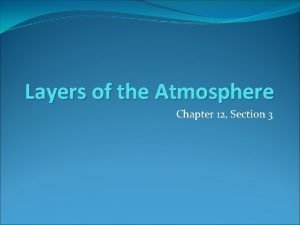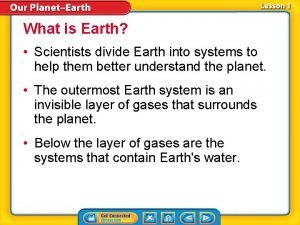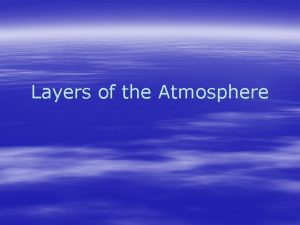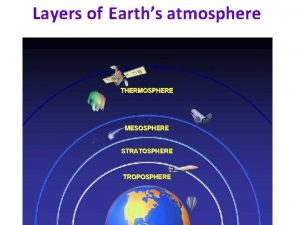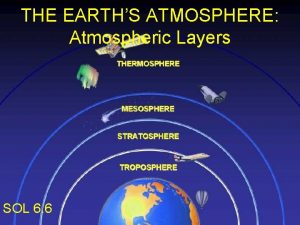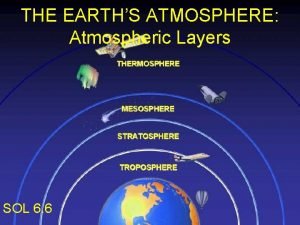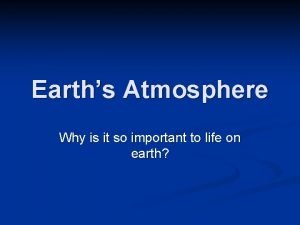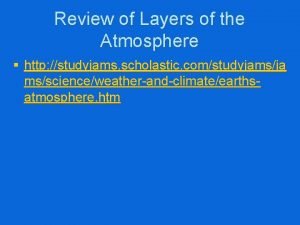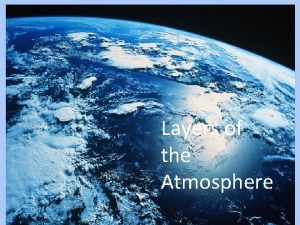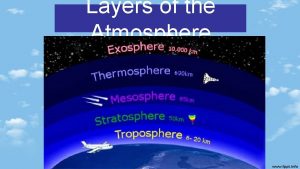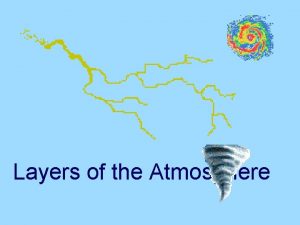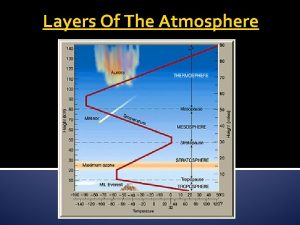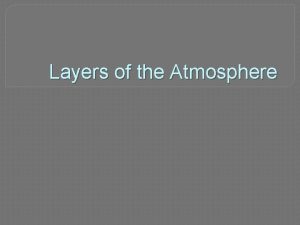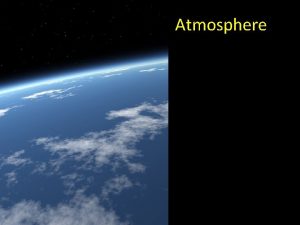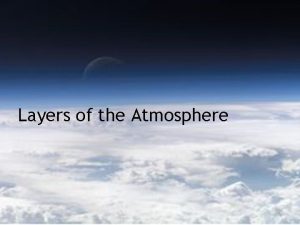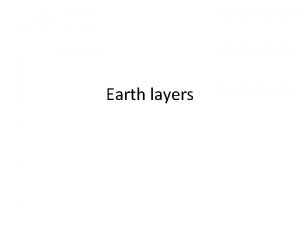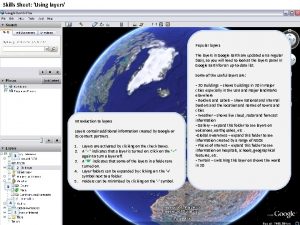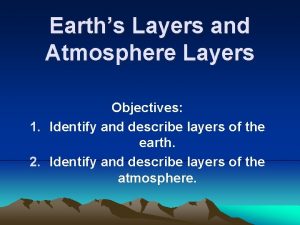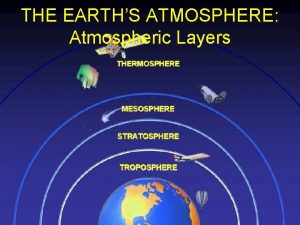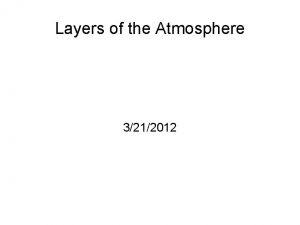Layers of the Atmosphere Atmosphere The atmosphere is


















- Slides: 18

Layers of the Atmosphere

Atmosphere • The atmosphere is the blanket of gases that surrounds the Earth • The atmosphere contains about: ▫ 78% Nitrogen ▫ 21% Oxygen ▫ 1% other gases such as Argon, Carbon Dioxide, and Water Vapor

Ozone • Ozone is formed by the addition of a third oxygen atom to an oxygen molecule • Protects us from UV Radiation ▫ CFC’s can deplete ozone

Atmosphere • The atmosphere is divided up into 4 different layers: ▫ ▫ Troposphere Stratosphere Mesosphere Thermosphere


Troposphere • The Troposphere is the layer closest to Earth ▫ ▫ Contains most of the mass of the atmosphere Most weather takes place in the troposphere Temperature decreases The boundary marking the end of the troposphere is called the tropopause


Stratosphere • Above the tropopause is the Stratosphere ▫ Made up of ozone ▫ Due to the absorption of radiation temperature in the Stratosphere generally increases ▫ Stratopause

Mesosphere • The Mesosphere lies above the stratopause ▫ Due to a lack of ozone temperature generally decreases with increasing altitude ▫ The Mesopause marks the boundary of the Mesosphere

Thermosphere • The thermosphere contains a very small amount of the atmosphere’s mass but a great deal of it’s volume ▫ Temperatures can reach 1000 degrees Celsius ▫ Contained within the Thermosphere is the ionosphere which is an area made up of electrically charged particles and lighter gases

Atmospheric Energy

The Sun • The sun is the main source of energy for the atmosphere • Delivers energy to the Earth through: ▫ Radiation ▫ Conduction ▫ Convection

Radiation • Radiation-Transfer of energy through space by electromagnetic waves • Some energy is absorbed by the Earth some is bounced back into space ▫ 35 % of incoming energy is reflected back into space ▫ 15 % is absorbed by the atmosphere ▫ 50 % is absorbed by Earth’s surface • The energy that is absorbed by the Earth is then given off back into the atmosphere



Conduction • Conduction is the transfer of energy that occurs when molecules collide • Molecules move from the surface of the Earth to the closest layer of the atmosphere • Only heats the lower parts of the atmosphere

Convection • Transfer of energy by the flow of a heated substance • As the remaining energy rises into the atmosphere it cools and sinks back down to Earth until it heats up again ▫ Provides energy to the remainder of the atmosphere

 The four main layers of the atmosphere
The four main layers of the atmosphere Scientists divide the atmosphere into how many layers?
Scientists divide the atmosphere into how many layers? How are the layers of the atmosphere divided
How are the layers of the atmosphere divided Atmosphere layers definition
Atmosphere layers definition Layers of the atmosphere
Layers of the atmosphere Layers of the atmosphere song
Layers of the atmosphere song Layers of the atmosphere song
Layers of the atmosphere song Layers of atmosphere
Layers of atmosphere Study jams heat
Study jams heat Layer closest to earth
Layer closest to earth Các môn thể thao bắt đầu bằng tiếng bóng
Các môn thể thao bắt đầu bằng tiếng bóng Khi nào hổ mẹ dạy hổ con săn mồi
Khi nào hổ mẹ dạy hổ con săn mồi điện thế nghỉ
điện thế nghỉ Nguyên nhân của sự mỏi cơ sinh 8
Nguyên nhân của sự mỏi cơ sinh 8 Một số thể thơ truyền thống
Một số thể thơ truyền thống Trời xanh đây là của chúng ta thể thơ
Trời xanh đây là của chúng ta thể thơ Bảng số nguyên tố lớn hơn 1000
Bảng số nguyên tố lớn hơn 1000 Thiếu nhi thế giới liên hoan
Thiếu nhi thế giới liên hoan Tỉ lệ cơ thể trẻ em
Tỉ lệ cơ thể trẻ em
